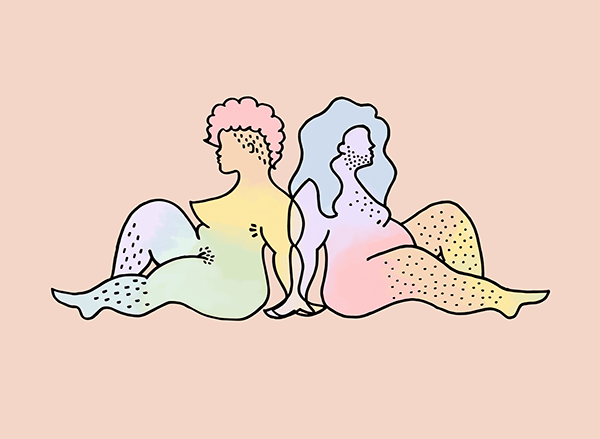Art and words by Jess
I hadn’t even hit puberty when I first learned about the double bind of femme body hair. On the morning bus ride to school, I witnessed a group of older white boys tease a brown girl for starting to grow armpit hair. The very next day, I witnessed the same boys tease her for having shaved it.
Eventually I would realize that the whole system was designed so that we can’t win. In the meantime, I developed a hair removal practice that was rooted in shame. Not in comfort or fashion or some misguided attempt at “good hygiene”, but in that plain old familiar shame. Shame that I have a body that grows hair in places it “clearly shouldn’t”. Shame that my body was somehow wrong.
I developed a hair removal practice that was rooted in shame.
For most of my young adulthood, I tried to mitigate that shame by removing my body hair or, at the very least, by covering it up. I thought that if no one could see it, then there’d be nothing to be ashamed of. The thing about shame is that (unlike embarrassment) it’s still there even when you don’t have an audience. My shame remained when I shaved and waxed and plucked all the hair off, because even if no one else could see it, I still knew that I had a body that grew thick, dark, curly hair—a body to be ashamed of.
As I discovered feminism and the bullshit that is patriarchy, I understood the body hair removal industry to be both a sinister grab at my time and money, and a fetishization of prepubescent femme bodies following the Equal Rights Amendment. (More recently, the nonbinary poet ALOK taught me that it is also a racist project toward white supremacy.) Even as I grew out my furry patches in a fervent attempt to rebel against this injustice, I still struggled to accept those dark scraggly hairs as beautiful and welcome on the landscape of my body.
Fast forward a decade, I’m standing naked in front of the mirror, trying to reconcile the many aspects of my body that cisnormative programming tells me don’t belong together. I’ve got full breasts and hair around my nipples, fleshy hips and unshaven legs, slender painted fingernails and a fuzzy upper lip. It’s hours of this, of practicing to see my body as non-binary, that leads me to love every bit of it. I remember that I am a creation of estrogen and testosterone and bits of stardust from many distant worlds. I understand that this body is a magical thing. I submerge myself in one of my very favourite passages by trans/non-binary writer Ivan Coyote: “I am not trapped in the wrong body; I am trapped in a world that makes very little space for bodies like mine.”
I realize that I’m much less concerned with what I’m going to do with my body hair, so much as how I feel about this body that grows hair. My personal hair grooming practices can have as much or as little to do with shame as I let it. It’s the shame itself that matters to me.
I realize that I’m much less concerned with what I’m going to do with my body hair, so much as how I feel about this body that grows hair.
I still remember the first time I realized it was even possible for me to shamelessly let my body hair grow. It was a hot summer day, my family and I were visiting my cousins in their desert valley. We had just finished our annual float down the river in black inner tubes, and were loading ourselves onto the uncomfortably humid, repurposed school bus that would drive floaters back up to the top of the river where our cars were parked. My older sister had opted to float the entire way in a sopping wet denim skirt to hide her unshaven pubic hair, as she had forgotten her razor at home.
I took my seat on one of those sticky brown vinyl school bus benches, and a queue of travellers walked past me to their own seats, their crotches at my eye level. One teenager, older than me but not by much, walked toward me in a blue striped bikini. Almost as soon as I noticed the bikini, I noticed the bikini line and the thick, dark, curly hair that filled the area around it. Though I would continue to groom my own bikini line for years afterward, it was at that precise moment that I thought, for the very first time, that it was possible to have pubic hair and not be at war with it. To just…let it be.
This memory still astounds me because it is the only one I have. If I had not been on that particular bus on that particular day, I could have spent my entire adolescence never seeing a public display of femme pubic hair. I consider myself lucky to have this encounter, but I am also grateful. Grateful that I crossed paths with someone who, by simply accepting their body the way it was, gave me permission to accept my own.
Invoking the power to love my body is never about getting others’ approval; it is about giving approval to myself.
Today, when I think of empowering others to love their bodies and be fully themselves, I still think of the blue bikini-clad teenager on the bus. They didn’t empower me by telling me my body hair is beautiful the way it is. I didn’t empower them by giving them a thumbs-up as they boarded the bus with a full bush. Queer author-activist Sonya Renee Taylor said: “Radical self-love summons us to be our most expansive selves, knowing that the more unflinchingly powerful we allow ourselves to be, the more unflinchingly powerful others feel capable of being. Our unapologetic embrace of our bodies gives others permission to unapologetically embrace theirs.”
Invoking the power to love my body is never about getting others’ approval; it is about giving approval to myself. And then, as I learn to love my own body, I empower others to love their own.
Jess (she/they) is a queer feminist thinker, writer, artist, and Certified Sexual Health Educator. Most of their work involves prioritizing pleasure, healing from shame, and sharing knowledge for collective empowerment. She lives with her two young children on an island in the unceded territory of the Coast Salish peoples, where they enjoy being surrounded by flora, fauna, and bodies of water.

